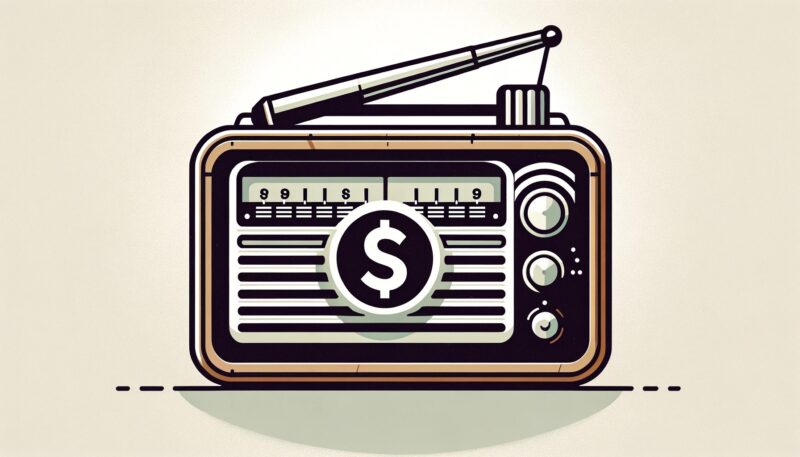Hey there, advertising enthusiasts and budget-conscious business owners! Ever wondered how much it costs to look into the world of radio advertising?
Well, you’ve come to the right place. We’re about to spill the beans on all things radio advertising costs and trust us, it’s more than just a shot in the dark.
From market size to ad length, we’re diving deep to help you navigate the radio waves without breaking the bank.
Factors Influencing Radio Advertising Costs

The first and perhaps most significant factor influencing radio advertising costs is the market size and location where you plan to run your ads. Larger markets, such as major cities or densely populated areas, typically command higher advertising rates due to their larger audience reach.
Smaller markets, on the other hand, offer more affordable options but may have limited exposure. Market location also plays a role.
Advertising in prime locations, like New York City or Los Angeles, is often more expensive than in smaller towns or rural areas. It’s essential to assess your target audience’s geographic location and size to determine the most cost-effective market for your advertising campaign.
| Location | Expense Level | Description |
|---|---|---|
| New York City | Very Expensive | One of the most expensive markets due to high demand. |
| Los Angeles | Very Expensive | Competitive market with high rates for prime slots. |
| Chicago | Expensive | A major city with moderate to high advertising costs. |
| San Francisco | Expensive | Higher costs due to a tech-savvy and affluent audience. |
| Miami | Moderate | Costs are relatively balanced in this metropolitan area. |
| Atlanta | Moderate | A mid-sized city with average radio advertising rates. |
| Denver | Affordable | A mid-sized city with more reasonable advertising costs. |
| Nashville | Affordable | Smaller market with lower rates for radio advertising. |
| Boise, Idaho | Very Affordable | A smaller town with some of the lowest advertising costs. |
| Rural Nebraska | Very Affordable | Rural areas typically offer the most budget-friendly options. |
Time of Day
The time of day you choose to air your radio ads significantly impacts the cost. Radio stations divide their programming into different time slots, each with its rate card.
These slots generally fall into the following categories:
- Prime Time: This includes the morning and evening rush hours when radio listenership is at its peak. Advertising during prime time is more expensive but ensures a broader audience reach.
- Daytime: Mid-morning and early afternoon slots are considered daytime hours. They are less expensive than prime time but can still offer substantial listenership.
- Overnight and Off-Peak: Late-night and early morning slots are the least expensive options. While they may have fewer listeners, they can be a cost-effective choice for businesses with limited budgets.
The cost of radio advertising will vary depending on the time slot you choose, with prime time slots commanding the highest rates.
Station Popularity and Format
Radio stations have different formats and listener demographics. Stations that cater to specific niche markets or genres may charge higher rates for targeted advertising.
The popularity and reputation of the station also influence costs. High-rated stations often charge a premium for ad space because of their broader listener base and trustworthiness.
It’s crucial to select radio stations that align with your target audience. For instance, if you’re promoting a local auto repair shop, advertising on a station that focuses on automotive content may be more effective and cost-efficient than a general-interest station.
Ad Length and Frequency
The length and frequency of your radio ads are significant cost determinants. Radio advertisements typically come in various lengths, including 15 seconds, 30 seconds, and 60 seconds.
Longer ads are more expensive, but they allow you to convey more information and create a more compelling message. Additionally, the frequency of your ads impacts the cost.
Running your advertisement more frequently during a specific time slot or throughout the day will require a higher budget. Balancing the length and frequency of your ads is crucial to optimize your advertising budget.
Ad Length and Cost:
- 15-Second Ads: These are the shortest and most budget-friendly radio ads. While they offer limited time for your message, they can be effective for conveying concise information, especially for promotions or brand reminders.
- 30-Second Ads: A 30-second radio ad provides more time to deliver your message compared to a 15-second ad. It strikes a balance between brevity and information dissemination. It is a popular choice for many advertisers.
- 60-Second Ads: These are the longest standard radio ad lengths. They offer ample time to tell a more detailed story, present testimonials, or include a call to action. However, they come at a higher cost due to their extended duration.
The choice of ad length depends on your advertising goals, budget, and the complexity of your message. While longer ads allow for a more comprehensive message, they may not always be necessary.
For some campaigns, a concise 15-second ad can be just as effective in capturing the audience’s attention.

Ad Frequency and Cost:
The frequency of your radio ads refers to how often they air during a specific time slot or throughout the day. Here’s how ad frequency impacts your advertising budget:
- Low Frequency: Running your ads at a lower frequency means they will air fewer times. This option is cost-effective, making it suitable for businesses with limited budgets. However, it may take longer to achieve your advertising goals since your message reaches the audience less frequently.
- Moderate Frequency: A moderate frequency involves airing your ads consistently but not excessively. It strikes a balance between cost and visibility. This approach is commonly used to maintain brand awareness and deliver essential messages.
- High Frequency: Running your ads frequently during a specific time slot or throughout the day increases your campaign’s visibility but also escalates costs. High-frequency advertising is ideal for time-sensitive promotions or when you want to saturate the market quickly.
Balancing ad length and frequency is crucial for optimizing your advertising budget. Here’s how you can strategize effectively:
- Clear Objectives: Determine your campaign objectives. If your goal is to create brand awareness, you may opt for shorter ads with a higher frequency. For product promotions or detailed messages, longer ads with moderate frequency may be more suitable.
- Testing and Analytics: Use A/B testing and analytics to evaluate the performance of different ad lengths and frequencies. Measure the impact on key performance indicators (KPIs) such as website visits, call inquiries, or sales conversions. This data-driven approach will help you refine your strategy over time.
- Seasonal Adjustments: Consider adjusting your ad length and frequency based on seasonal demand or specific events. During peak seasons, you might increase the frequency to capitalize on higher consumer interest.
- Budget Allocation: Allocate your budget strategically between ad length and frequency. Remember that it’s not just about how much you spend but how effectively you allocate those funds to achieve your advertising goals.
Seasonality and Demand
Radio advertising costs can fluctuate based on seasonality and demand. Certain times of the year, such as holiday seasons or major events like the Super Bowl, may drive up ad prices due to increased competition for airtime.
Conversely, during slower periods, you may find more affordable rates.
- 🎄 Christmas Season: Ad prices often soar during the festive holiday season as businesses compete for airtime to promote their holiday specials and gift ideas.
- 🎃 Halloween: Leading up to Halloween, expect an increase in ad costs as advertisers vie for slots to showcase their spooky promotions and costume deals.
- 🏈 Super Bowl Sunday: The Super Bowl is a mega advertising event, and ad prices skyrocket during this time as companies aim to reach a massive viewership.
- 🌞 Summer Vacation: As summer approaches, travel and leisure-related businesses may face higher ad rates as they target vacationers and families planning trips.
- 🌸 Valentine’s Day: In the weeks leading up to Valentine’s Day, ad costs may rise as retailers and restaurants advertise romantic getaways and gifts.
- 🎉 New Year’s Eve: Celebrating the start of the new year can come with higher advertising costs, especially for venues and event organizers promoting New Year’s Eve parties.
- 🌺 Spring Break: Travel agencies and destinations often experience an uptick in ad rates as they advertise spring break getaways for students and families.
- 🍂 Back-to-School Season: Retailers and school-related businesses may see increased competition and advertising expenses as they target students and parents during back-to-school shopping.
- 🇺🇸 Independence Day: Leading up to the Fourth of July, expect higher ad prices as businesses promote patriotic sales, barbecues, and fireworks displays.
- 🍁 Fall Harvest: Farms, orchards, and pumpkin patches may experience higher demand and ad rates as they advertise fall activities like apple picking and hayrides.
Remember to plan your radio advertising campaigns wisely, taking into account these seasonal trends and events to optimize your budget and reach your target audience effectively.
Negotiation Skills

Lastly, your negotiation skills and ability to build relationships with radio station representatives can significantly impact the cost of your advertising campaign. Building a good rapport with station sales teams may lead to better deals, discounts, or added value to your advertising package.
Pricing Models
| Pricing Model | Description | Formula |
|---|---|---|
| Cost Per Point (CPP) | Measures the cost of reaching 1% of the target audience within a specific market. | CPP = Total Campaign Cost / Total Rating Points |
| Cost Per Thousand (CPM) | Represents the cost of reaching one thousand listeners or impressions. | CPM = (Total Campaign Cost / Total Impressions) x 1,000 |
Flat Rate
Some radio stations offer flat-rate pricing, where advertisers pay a fixed fee for a specified time slot or ad placement. Flat-rate pricing simplifies budget planning, as you know exactly how much you’ll be charged for your ads.
However, the flat rate can vary significantly based on factors such as market size, time slot, and station popularity.
Sponsorships and Promotions
Sponsorships and promotions involve a more customized pricing model. In these arrangements, advertisers work closely with the radio station to create unique content or experiences for listeners.
The cost of sponsorships and promotions varies widely based on the level of customization and the specific elements included in the package.
Package Deals
Many radio stations offer package deals that bundle multiple ad placements and services at a discounted rate. These packages often include a combination of prime time and off-peak slots, different ad lengths, and sometimes digital advertising components.
Package deals can provide cost savings and a well-rounded advertising strategy.
Strategies for Cost-Effective Radio Advertising
Now that you understand the factors influencing radio advertising costs and the various pricing models, let’s explore some strategies to make the most of your advertising budget:
Set Clear Objectives
Before starting your radio advertising campaign, define clear objectives and goals. Determine what you want to achieve with your ads, whether it’s increasing brand awareness, driving website traffic, generating leads, or boosting sales.
Having well-defined objectives will help you allocate your budget effectively and measure the success of your campaign.
Target the Right Audience
Identify your target audience and choose radio stations that cater to that demographic. Advertising on stations that align with your audience’s interests and preferences ensures that your message reaches the people most likely to convert into customers.
This targeted approach can lead to better results and a higher return on investment.
Optimize Ad Length and Frequency
Carefully consider the length and frequency of your radio ads. While longer ads may convey more information, they come at a higher cost.
Striking a balance between ad length and frequency is essential. Conduct A/B testing to determine which ad lengths and frequencies yield the best results for your campaign.
Negotiate with Radio Stations
Don’t be afraid to negotiate with radio stations to secure the best rates and added value for your advertising campaign. Building positive relationships with station representatives can lead to discounts, extended airtime, or inclusion in promotional events.
Be prepared to leverage your negotiation skills to maximize your budget.
Measure and Analyze Results
Once your radio advertising campaign is underway, continuously monitor and analyze its performance. Use tracking tools and metrics to assess the impact of your ads on key performance indicators (KPIs).
By measuring results, you can make informed adjustments to your campaign to improve its effectiveness and cost-efficiency.
Consider Multichannel Marketing
Radio advertising can complement other marketing channels, such as digital advertising or social media. Implementing a multichannel marketing strategy allows you to maximize your reach and engage with your audience across various touchpoints.
Coordinating your efforts across different channels can lead to a more comprehensive and cost-effective campaign.
FAQs
Final Words
So there you have it, folks—your crash course in radio advertising costs. We’ve unveiled the secrets behind market sizes, time slots, and ad lengths, helping you understand how to make the most of your advertising budget.
Remember, it’s not just about how much you spend but how wisely you spend it. With the right strategies and a dash of creativity, you can make radio advertising work wonders for your brand without burning a hole in your wallet.
Now, go out there, tune in, and make some waves with your radio ads!
